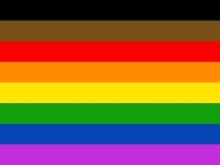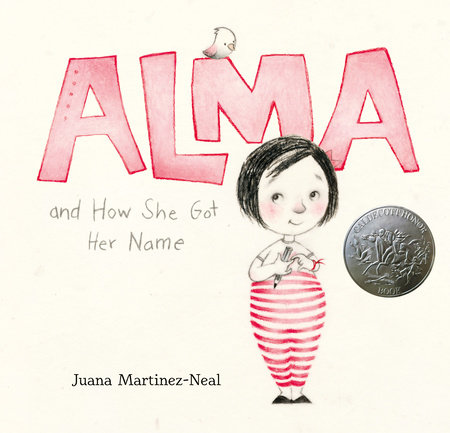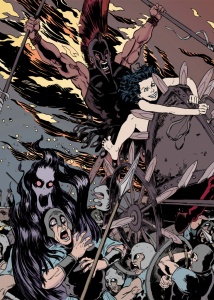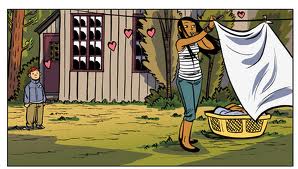I realize it is only May – the 5th month of the year but I am fairly confident when I say this decade is a dozy.
- January highlights included the presidential campaign – emphasis on PAIN – spillover from 2019.
- The American Dirt “novel” White-pendeja-fest (technically started in 2019) it really hit level 1000 in January 2020. Please read Myriam Gurba’s most excellent and historic literary criticism (here).
- February seemed fairly normal. Racism, homophobia, and sexism but nothing out of the ordinary. Near the end of the month started hearing about COVID19 cases.
- A colleague got yelled at for coughing while Asian on public transportation.
- I overheard a second grader say, “I hate Chinese people because they are killing us with germs”
- February lulled us into complacency and then March came in like a blind-folded, dizzy 11 year old swinging a piñata pole.
- Everything was cancelled. School, travel plans, everything that made my schedule was cancelled. Except racism. Racism is never cancelled. Anti-Asian racism went into hold-my-beer-over-time.
- April lasted approximately 70 years. I tried to be a teacher, colleague, parent, partner, and dog owner. I’m pretty sure I failed epically on a regular bases but I was too busy trying to understand how so many people were dying to notice or breath long enough to regret my actions.
- May is here. I’m exhausted. I wondered why, so I decided to take a close look at one typical week via my Twitter feed. A sort of close-reading of my world as a White presenting, lesbian Latina with a long time partner that I love dearly, two teen sons, two dogs, and work that centers bringing #OwnVoices books into k-12 classrooms.
MONDAY May 4, 2020
 I sign onto Twitter planning to spent my regular 10 minutes of Monday morning reporting racist anti-Asian/COVID19 garbage. I note that on May 2, 2020 Shana White, Ed.S (@ShanaVWhite) posted the following question about “Adam and Carly’s STEM Summit“
I sign onto Twitter planning to spent my regular 10 minutes of Monday morning reporting racist anti-Asian/COVID19 garbage. I note that on May 2, 2020 Shana White, Ed.S (@ShanaVWhite) posted the following question about “Adam and Carly’s STEM Summit“
I’m not in the STEM field, but my partner is, so I know a lot of the folks in the field. Plus, SHANA WHITE!!! is all that & a bag of chips in her real-ness around anti-racist education.
I read through the responses – as one does – and I see that Adam and Carly decided to block the holy-patoo-ties out of anyone who pointed out the White avalanche of presenters. I also note the defenders clutching at their pearls about BIPOC being mean to Adam and Carly. Since I have yet to be blocked, I respond naming the racism.
That evening shea martin (@sheathescholar) invites me to participate with them and Shana White on a 30 min Zoom meeting with Adam and Carly. For reasons I still do not fully comprehend, I agree.
I blame the continuing stay-in-place order.
Tuesday May 5, 2020
Cinco de Mayo – ugh. Twitter is filled with “wine-marg-time” ads and Tweets featuring teachers in tiny sombreros and oversized mustaches. It’s a lot.
Run a “remote teaching in higher ed” PD for the faculty in my college.
Grade.
 Zoom call with shea, Shana, Adam, and (eventually) Carly that turns out to be an hour-long White Fragility art installation.
Zoom call with shea, Shana, Adam, and (eventually) Carly that turns out to be an hour-long White Fragility art installation.
Highlights (I am paraphrasing because I did not record, but I really should have!) include;
-Adam expresses dismay and regret.
-Adam says the actual words “We have a dear black friend” All THE WAY OUT LOUD.
-Adam says Carly taught ‘hispanics’ in Indianapolis.
-He has been reading White Fragility by Dr. Robin Diangelo for 2 days and is learning so much.
-By the time Carly joins more than 30 excuse-laden-minutes have passed.
-Carly expressed regret, and assures us she is learning and has met some amazing people through this experience. She also cries.
-Carly says something like ‘Our black friend told us some people might take issue with our summit being all white but I didn’t know how to find Black STEM teachers’. shea googled Black STEM teachers for Adam and Carly to show them it is possible.
Ruh-Ro-Shaggy! My head snaps back – They were warned, they went ahead with an all White STEM summit anyway. Then when they got called out, they blocked the ba-jeebers out of eveyone. They went and unblocked folks, and now have seen the error of their racist ways. They want to fix everything as soon as possible and they are committed to topping off the STEM summit’s tank with some extra mellanin.
Shana, shea and I tell them the summit needs to be delayed. They need to do The Work – critical intersectionality work which needs to be more than performative. And, it will take more than one book and 2 days. They claim they cannot delay the summit and ask for our forgiveness and our guidance.
It is 2020. I have been on Zoom with these people for an eon, an era, perhaps an epoc. I finally tell them what this experience is like for marginalized people …
It is as if you run BIPOC folks over with your car because you cannot see us through the unearned privilege blocking your view. Then you lean out the window, ask us for directions, because you are so flustered by the act of running us over with your car.
They did not understand. They are not delaying. They refuse to do The Work. I am unsurprised.
Wednesday May 6, 2020
I start reading other #31DaysIBPOC and begin to panic. I did not sleep well. I am having COVID dreams about talking animals and being in charge of things I do not understand or have any reason to be in charge.
I send the money that Adam and Carly paid for my time to #WeNeedDiverseBooks.
Murder wasps are a thing.
Grades are due or past due. We are still staying-at-home.
Thursday May 7, 2020
Prep for interview on with Jenni Bement on The Queer Pod. It is a much better way to spend an hour. My entire professional life is distilled into this;
I am asking White, straight, cis, able, middle class teachers to do The Work.
– Learn the oppressive history you were never taught.
– Read only #OwnVoices books!
– Bring Critical Intersectionality into the curriculum.
Work on a writing thing that I am way behind on. Computer crashes.
Work on another writing thing that I am even further behind on. Computer crashes.
Submit grades. Computer crashes.
Pearl clutching White teachers just want me to be kind since Adam and Carly are trying. I suspect my eyes are damaged from the constant rolling.
Friday May 7, 2020

White Savior-ness abounds. This White dude teaches Black and brown kids the history of rap music in Philly.
– He posts, and subsequently removed post highlighting his consumption and appropriation of BIPOC culture.
-Didn’t Dr. Christopher Emdin cover this already in For White Folks Who Teach in the Hood. Of course Dr. Emdin isn’t White, so he’s not edgy. He’s just educated.
Work on a writing thing that I am way behind on. Computer crashes.
Work on another writing thing that I am even further behind on. Computer crashes.
Hang out on Zoom with some queer ed scholars talking about the scary landscape of higher ed.
Spend a few hours trying to load new system, get backup to run, get university tech to remote fix my computer.
STAY IN PLACE
That’s it.
That’s my week.
There is nothing unique or out of the ordinary about all the White nonsense. It is ubiquitous, droning on like the leaf blowers in the suburbs on Spring days.
I close my second annual #31DaysBIPOC post with thanks for all the wonderful BIPOC and LGBTQIA people that share in The Work.
We are all around. We do The Work for ourselves, each other, and generations to come. We call each other out, and call each other in, out of love and respect. We celebrate, laugh, and cry across vast differences and distances because we believe in ourselves and our value.
We have to.
P.S.

If you teach STEM, get your STEM on here ….
Read yesterday’s #31DaysBIPOC post by Lorena Germán





 The majority of the book takes place at the local pool, with some short hops into the ER (drama!) and Alexis’s house. This setting is a convenient conceit, but it also gives the characters the all important parent-free hours to talk about life, family, love, bullies, and the impending change from middle to high school. Another aspect I appreciate about this book is the effortless character diversity.
The majority of the book takes place at the local pool, with some short hops into the ER (drama!) and Alexis’s house. This setting is a convenient conceit, but it also gives the characters the all important parent-free hours to talk about life, family, love, bullies, and the impending change from middle to high school. Another aspect I appreciate about this book is the effortless character diversity.



 The protagonists in these graphic novel series that Matt selected for his class and recommended for your classes, the results were just as disappointing. The vast majority of the characters were either White or NOT HUMAN. That’s right, you have a better chance of seeing yourself reflected in these books if you are a talking rabbit or a Yeti, rather than Latinx, Black, Asian, Indigenous/Native American, or Middle Eastern person.
The protagonists in these graphic novel series that Matt selected for his class and recommended for your classes, the results were just as disappointing. The vast majority of the characters were either White or NOT HUMAN. That’s right, you have a better chance of seeing yourself reflected in these books if you are a talking rabbit or a Yeti, rather than Latinx, Black, Asian, Indigenous/Native American, or Middle Eastern person.
 The “single story” graphic novels on the list were a bit different when it came to gender. Here there are more female protagonists. There were still no no gender non-conforming characters, and the 2 LGBTQ characters (both male) were written by a straight woman.
The “single story” graphic novels on the list were a bit different when it came to gender. Here there are more female protagonists. There were still no no gender non-conforming characters, and the 2 LGBTQ characters (both male) were written by a straight woman.



 Alma, by Juana Martinez-Neal
Alma, by Juana Martinez-Neal When We Were Alone by David Robertson and Julie Flett.
When We Were Alone by David Robertson and Julie Flett.

 form graphic novel and he’s pulled off a brilliant balance between simple lines and illustrations and a charming story.
form graphic novel and he’s pulled off a brilliant balance between simple lines and illustrations and a charming story. of the princess which is something no one else in the castle thinks to do. She has been running around all day, hasn’t eaten and feels lightheaded. He not only rushes to her side, he also pulls tea and muffins from his chefs hat and gets the job. But more importantly, he begins a friendship with the princess.
of the princess which is something no one else in the castle thinks to do. She has been running around all day, hasn’t eaten and feels lightheaded. He not only rushes to her side, he also pulls tea and muffins from his chefs hat and gets the job. But more importantly, he begins a friendship with the princess.
 and change my syllabus for next semester’s children’s and YA literature course to reflect the research I saw at LRA. But, before all that started, I found the latest in George O’Connor’s Olympians series in my mailbox!!!
and change my syllabus for next semester’s children’s and YA literature course to reflect the research I saw at LRA. But, before all that started, I found the latest in George O’Connor’s Olympians series in my mailbox!!!







